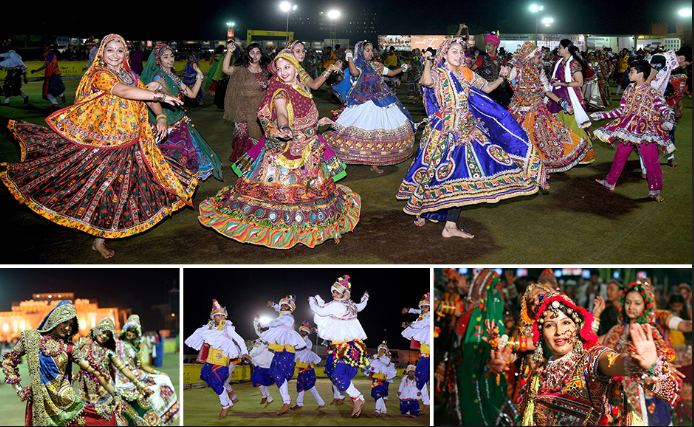Hope you all are acquainted with the flourishing state of GUJARAT which is known for its rich heritage and cultural diversity. The fast-developing westernmost state of GUJARAT is not only known for being home to the endangered species of Asiatic Lions, its vast salt coverings of Kutch, or for being one of the cardinal points of the holy char dham yatra of India but it is also known all over the world for being a culturally colourful mosaic of age-old traditions and also for being blessed with an opulent collection of heritage.
Do you know which state is known as “The Jewel of Western India”? From which state the logo of SBI (State Bank of India) has been inspired?
Let’s start exploring this state by covering the above questions as well as some of the interesting facts and aspects.
Therefore, in this article, the cultural, political and geographical aspects of Gujarat will be covered. But before starting with this alluring state, let’s look at some of its State Symbols –
| State Capital | Gandhinagar |
| State Animal | Asiatic Lion |
| State Bird | Greater Flamingo |
| State Flower | Marigold |
| State Tree | Banyan |
| State Dance | Garba |
| State CM (Present) | Vijay Rupani |
| State Governor (Present) | Acharya Dev Vrat |
So, let’s begin with the aspect which is the vibrant blend of traditions, beliefs, customs, arts, values and modernization.
Table of Contents
Gujrat CULTURE GK Notes
Gujarat carries its own culture and tradition which is clearly visible in day to day activities of people.
- DANCE FORMS – There are four main dance forms which are Dandiya Raas, Garba, Garbi and Padhar.
- Dandiya Raas: This dance is characterized by being energetic, playful, along with being romantic. Dandiya Raas is performed by both men and women and utilizes the movement of bamboo sticks, known as Dandiyas. It has ancient roots and was believed to be played by the beloved Gopis of Lord Krishna on the shores of Yamuna River on a moonlit night. The men and women taking part in this dance dress themselves up in traditional colourful clothing and dance around while simultaneously moving in concentric circles.
- Garba: Navaratri is the most colourful and prominent festival of the state celebrated for nine days preceding Dusshera. Another interesting feature of Navratri is Garba. Garba is a graceful traditional dance form that is performed primarily by women arranged in a circular form. This dance is performed to offer reverence to goddess Ambaji. The dance involves rhythmic singing and clapping while moving around the goddess.
- Garbi – Earlier this dance form was performed by the men of the Gujarati community. They used to perform this dance when they returned victoriously back from a battle. The dance incorporates the use of instruments like dhol and manjiras. The songs on which they used to dance used to be the spirit of valour and this dance was the characteristic of fascinatingly forceful movements. Nowadays even women take part in this dance.
- Padhar – This dance is performed by a rural community living around Nal Lake. In it, performers stimulate the rhythmic movements of roving mariners and the undulating sea waves.
- FAIRS AND FESTIVALS – The fairs and festivals of Gujarat showcase the real vibrancy and colours of its diverse culture. Apart from festivals such as Navratri Mahotsav, Deepawali, Kite festival, etc, there are some fairs as well namely – Shamlaji Melo, Bhadra Purnima Fair and Mahadev Fair.
- Rann Utsav – The Rann Utsav is a major festival and witnesses an exquisite carnival of music, dance and natural beauty. The ‘Kutch Festival’ or the ‘Rann Festival’ is celebrated at the time of the Shiv Ratri in February/ March. The centre of the festival is Bhuj in Kutch. It has crafts, fairs and folk dances and music and cultural shows.
- International Kite Festival – The Makar Sankranti, also known as Uttarayan in Gujarat, is another popular festival. On 14 January, when Sun enters the Tropic of Cancer, Makar Sankranti festival is observed. The International Kite Festival is celebrated on this day. This is one of the most colourful events in Gujarat when whole of the sky is filled with colourful kites all around.
- Bhavnath Mahadev Mela – This Fair takes place at the Bhavnath Mahadev Temple that is located on the foot of the holy mount Girnar in Junagadh. This fair takes place for 5 days in the month of February around the festival of Mahashivratri. During this festival, the Mahapuja of Lord Shiva takes place at midnight inside the temple on the 14th day of the dark half of the month of Magh. It is a popular belief that during this time, Lord Shiva himself visits the shrine.
- Modhera Dance Festival – Modhera is the Sun temple at Modhera in Mehsana district of Gujarat. Though the temple is in ruins, it is considered as one of the best specimens of Indian Art and Architecture of the bygone era. The beautiful sun temple forms as the backdrop during the festival of Indian classical dances held every year in January for three days.
- In Gujarati dishes, the flavours are a perfect amalgamation of sweet, spicy and sour tastes.
- A typical Gujarati dinner includes Bhakri-Shak or Khichdi-Kadhi.
- The typical thali of Gujarati consists of daal, roti (flat roasted bread of wheat flour), kadhi (a sumptuous curry of yogurt and fried puffs, spruced up with spices and cut vegetables), a vegetable dish and rice.
- The Gujarati’s are noted for their sweet tongue and every meal will be accompanied by a sweet dish. Aam Shrikhand is a rich tropical flavoursome yogurt-based dessert, made with curd and spiced with saffron, cardamom, nuts and chopped mangoes.
- KHANDVI is the popular Gujarati cuisine made in the form of thin layers of gram flour that is cooked in buttermilk and converted into delicious small roles. For the final stages, these rolls are seasoned and sautéed with sesame seeds as well as other spices.
- UNDHIYU – The word Undhiyu is derived from Gujarati “Undhu”, which means inverted literally. This is called so since this dish is prepared using an inverted clay plot. This is prepared using a combination of eggplant, papdi, surt, methi and bananas.
- Gujarati language is an Indo-Aryan language evolved from Sanskrit. This is the 26th most widely used language in the world. Gujarati has about 11 different dialects, spoken in various parts of the state. Whereas some people of Kutch speak Kutchi while Memoni is also spoken among Sindhi Memons and Muslims.
- Patola Silk (from Patan), also known as “Queen of all silks” forms a major part of Gujarati attire. The ‘Bandhani’ work of Jamnagar and ‘Zari’ work of Surat is also renowned.
- The main dress of women during the Navratri Festival is Chaniya and Choli, while men wear Chorno and kediyu.
- Gujarati brides are adorned with silk and zari woven sarees of Gharchola and Panetar. The traditional attires often incorporate tie-dye or traditional block prints.
- A prevalent Gujarati Trend is the Silver Pachchikam Jewellery that originated in Kutch.
- A number of Ragas emerged in this state such as Khambavati, Gujaqri, Todi Bilaval, Lati and Ahiri. It is said that the legendary musicians Baiju Bawra and Tana Kiri also belonged to this state.
- 20% of the population constitute tribal groups like Bhils, Kolis, Dhubla, Naikda and Macchi-Kharwa who still exist in the state.
Next, we will be dealing with the mainland of Gujarat i.e. –
Gujrat GEOGRAPHY GK Notes
Gujarat is a peninsular state lying on the western coast of India. It is almost surrounded by the Arabian Sea on its three sides. Physically, the mainland of Gujarat can be divided into the coastal area, the plains and the eastern highlands. The mainland of Gujarat is alluvial plain partly formed by the annual flood-deposits of Sabarmati, Mahi, Narmada and Tapti Rivers.
- Latitudinal Extension – 200 N to 240 N
- Longitudinal Extension – 720 E
- Area – 1,96,024 sq.km
Rank in India – 5th
- Population – 60,439,692 (or more than 6 crore)
Rank in India – 9th
- Boundaries –
North-west: Pakistan’s Sindh Province
South-west: Arabian Sea
North-east: Rajasthan
East: Madhya Pradesh
South: Maharashtra, Union Territory of Daman and Diu and Dadar and Nagar Haveli.
- Gujarat has the largest coastline of 1600 km dotted with 41 ports: one major port, 11 intermediates and 29 minor ports.
- The Government of Gujarat has banned alcohol since 1960. This is one of the three Indian states to prohibit the sale of alcohol. The other two states are Bihar and Nagaland.
- The state of Bombay was divided into two states, i.e., Maharashtra and Gujarat by the Bombay (Reorganization) Act, 1960.
- The Sabarmati is the largest river in Gujarat followed by Tapti, although the Narmada covers the longest distance in its passage through the state.
- The Sardar Sarovar Project/Dam is a concrete gravity dam on the Narmada river in the Kevadiya near Navagam, Gujarat. The four Indian states, i.e., Gujarat, MP, Maharashtra and Rajasthan, receive water and electricity supplied from the Dam.
- Narmada River which originates from Amarkantak Plateau is one of the major rivers of peninsular India and also it is one of the only three rivers in peninsular India that run from East to West – the others being the Tapti River and the Mahi River. A riverfront project has been built on the Sabarmati River in Ahmedabad.
- Gujarat has some of the major mountain ranges of India including Aravalis, Vindhyas and Satpuras. There are Mandav hills in Gujarat whose highest point is Mount Girnar, which is also the tallest peak (1069m above the sea level) in the state.
- South of the Mandav Hills, there are Girnar Hills and Barda Hills. These two are volcanic mountains. Raj Pipla and Satmala Hills lie on the border of Maharashtra and Gujarat.
- The Kathiawar Plateau in Gujarat has a specialty that there is a radial drainage pattern of small rivers.
- Nal Sarovar Lake is a saline water lake and there is also a Ramsar Wetland which is the largest natural wetland in India.
- Saputara is the only hill station in the state located in Sahyadri/Western Ghats. Saputara town is part of the Dang district in Gujarat.
- Rann of Kutch – Rann of Kutch is a seasonal marshy saline clay desert located in the Thar desert. It is about 7500 km2 in the area and is reputed to be one of the largest salt deserts in the world. This area has been inhabited by the Kutchi people. It was designated as a world heritage site on 5th November 2002. With an area of 45674 km2, Kutch is the largest district in India. Kutch means “something that becomes wet and dry intermittently.
- Physiographically it has four geographical regions –
- The Kathiawar Peninsula or Saurashtra
- The Kachchh Peninsula
- The Rann of Kachchh
- The Gujarat Plain
Now, the last one is related to the state’s complete structure i.e. –
Gujrat POLITY GK Notes
The Legislature of Gujarat is a Unicameral Legislature i.e. it only has Legislative Assembly and not Legislative Council.
- There are 182 seats in the Legislative Assembly.
- Number of Districts: 33
- The first capital of Gujarat was Ahmedabad but later the capital was moved to Gandhinagar in the year 1970. Gandhinagar is a planned city whereas Ahmedabad is the largest city.
- The High Court of the state is Gujarat High Court and its present Chief Justice is Vikram Nath.
- Representation of Gujarat in Parliament –
Rajya Sabha: 11
Lok Sabha: 26
- The first CM of Gujarat was Jivraj Narayan Mehta. He served as the first “Dewan” of the erstwhile Baroda State, and Indian High Commissioner to the United Kingdom from 1963 to 1966. He was from INC Party. His term of Office was from 1960 to 1963.
- The first Governor of Gujarat was Mehndi Nawaz Jung. He was an Indian bureaucrat and was Secretary to the Executive Council during the Nizam rule. He also served as the Governor of Gujarat from 1960-1965.
- The 14th Gujarat Legislative Assembly Election, 2017 was held on 9 December – 14 December 2017. The election was won by the incumbent BJP with an increase in the vote share.
To end this article on an interesting note, here are Some Interesting Facts about Gujarat –
- World’s Tallest Statue of Unity – Dedicated to the Indian Independence Movement Leader, Sardar Vallabhbhai Patel, the Statue of Unity stands tall at 182 metres. The statue is located on the river island Sadhu Bet in Narmada district, Gujarat. It is facing the Sardar Sarovar Dam on the river Narmada in the Kevadiya Colony.
- AMUL and The White Revolution – Anand Milk Union Limited, better known as AMUL is based out of Anand in Gujarat. An Indian Dairy Cooperative, AMUL is managed by the Gujarat Cooperative Milk Marketing Federation Limited, which is the largest food products marketing organization in India and is jointly owned by 3.6 million milk producers in Gujarat. AMUL started the White Revolution in the country and today India is the world’s largest producer of milk and milk products.
- Surat, The Diamond City of India – Surat is a major world hub for diamond cutting and polishing and is considered to be one of the richest cities in India in terms of per capita income. Almost 8 out of 10 diamonds are sold in the world are polished in Surat. It is also the Third cleanest city in India after Chandigarh and Mysore.
- SBI Logo – The logo of SBI (State Bank of India), the blue circle with a keyhole in the centre and a cut at the bottom, was inspired by a Kankaria Lake in Ahmedabad.
- Narendra Damodardas Modi, the 14th and current PM since 2014, was also the Chief Minister of Gujarat from 2001 to 2014. He is the first PM outside of the Indian National Congress to win two consecutive terms with a full majority and the second to complete five years in office after Atal Bihari Vajpayee.
So, here we come to the end of this blog. In our upcoming blog, we will be learning about the other aspects of Gujarat.
Do you know what is the GDP of Gujarat? In which state Gir National Park located?
Such engrossing aspects and facts of this state will be covered in the next part of the blog. If you don’t want to miss it, click here – Know your State ‘Gujarat’ – Part 2. Hope all this will going to help you in your competitive exams such as SSC 10+2, SSC CGL, CDS, NDA, etc.
Thank You




